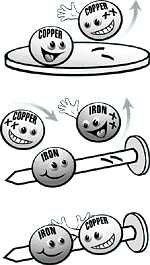|

Why did the pennies look dirty before I put them in the vinegar?
Everything around you is made up of tiny particles called atoms. Some
things are made up of just one kind of atom. The copper of a penny, for
example, is made up of copper atoms. But sometimes atoms of different kinds
join to make molecules. Copper atoms can combine with oxygen atoms from
the air to make a molecule called copper oxide. The pennies looked dull
and dirty because they were covered with copper oxide.
Why did the vinegar and salt clean the pennies?
Copper oxide dissolves in a mixture of weak acid and table salt-and vinegar
is an acid. You could also clean your pennies with salt and lemon juice
or orange juice, because those juices are acids, too.
Why did the unrinsed pennies turn blue-green?
When the vinegar and salt dissolve the copper-oxide layer, they make
it easier for the copper atoms to join oxygen from the air and chlorine
from the salt to make a blue-green compound called malachite.
How did the nail and the screw get coated with copper?
To understand how the nail and screw got coated with copper, you need
to understand a little bit more about atoms. Atoms are made up of even smaller
particles called protons, neutrons, and electrons. Electrons and protons
are both electrically charged particles. Electrons are negatively charged
and protons are positively charged. Negative charges attract positive charges,
so electrons attract protons.
 When
you put your dirty pennies in the vinegar and salt, the copper oxide and
some of the copper dissolve in the water. That means some copper atoms leave
the penny and start floating around in the liquid. But when these copper
atoms leave the penny, they leave some of their electrons behind. Rather
than having whole copper atoms in the liquid, you've got copper ions, copper
atoms that are missing two electrons. These ions are positively charged.
When
you put your dirty pennies in the vinegar and salt, the copper oxide and
some of the copper dissolve in the water. That means some copper atoms leave
the penny and start floating around in the liquid. But when these copper
atoms leave the penny, they leave some of their electrons behind. Rather
than having whole copper atoms in the liquid, you've got copper ions, copper
atoms that are missing two electrons. These ions are positively charged.
Now add two steel nails and a screw to the mixture. Steel is a metal
made by combining iron, other metals, and carbon. As you found out when
you cleaned your pennies, your mixture of salt and vinegar is really good
at dissolving metals and metal oxides. When you put the steel nail in the
mixture, some of the iron dissolves. Like the copper atoms, each of the
iron atoms that dissolves leaves two electrons behind. So you've got positively
charged iron ions floating in your vinegar with the positively charged copper
ions.
Originally, the steel nail was neutrally charged-but when the iron ions
left their electrons behind, the nail then became neg-atively charged. And
remember what we said way back at the beginning of this section: negative
charges attract positive charges. The negative charges on the nail attract
positive charges in the liquid. Both the iron ions and the copper ions are
positively charged. The copper ions are more strongly attracted to the negative
charge than the iron ions, so they stick to the negatively charged nail,
forming a coating of copper on the steel.
Why did bubbles come off the steel screw?
Each water molecule is made up of two hydrogen atoms and an oxygen atom.
In an acid (like vinegar or lemon juice), lots of hydrogen ions (hydrogen
atoms that are missing an electron) are floating around. In the chemical
reactions at the surface of the screw, some of these hydrogen ions join
and form hydrogen gas. The bubbles that you see coming off the screw are
made of hydrogen gas.
|